
The United States Virgin Islands, officially the Virgin Islands of the United States, are a group of Caribbean islands and an unincorporated and organized territory of the United States. The islands are geographically part of the Virgin Islands archipelago and are located in the Leeward Islands of the Lesser Antilles.

The Danish West Indies or Danish Antilles or Danish Virgin Islands were a Danish colony in the Caribbean, consisting of the islands of Saint Thomas with 32 square miles (83 km2); Saint John with 19 square miles (49 km2); and Saint Croix with 84 square miles (220 km2). The islands have belonged to the United States since they were purchased in 1917. Water Island was part of the Danish West Indies until 1905, when the Danish state sold it to the East Asiatic Company, a private shipping company.

Charlotte Amalie, located on St. Thomas, is the capital and the largest city of the United States Virgin Islands. It was founded in 1666 as Taphus. In 1691, the town was renamed to Charlotte Amalie after the Danish queen Charlotte Amalie of Hesse-Kassel (1650–1714). It has a deep-water harbor that was once a haven for pirates and is now one of the busiest ports of call for cruise ships in the Caribbean, with about 1.5 million-plus cruise ship passengers landing there annually. Protected by Hassel Island, the harbor has docking and fueling facilities, machine shops, and shipyards and was a U.S. submarine base until 1966. The Town has been inhabited for centuries. When Christopher Columbus arrived in 1493, the area was inhabited by Caribs, Arawaks, Ciboney and Taíno native peoples. It is on the southern shore at the head of Saint Thomas Harbor. In 2010 the City had a population of 18,481, which makes it the largest city in the Virgin Islands Archipelago. Hundreds of ferries and yachts pass by the Town each week.
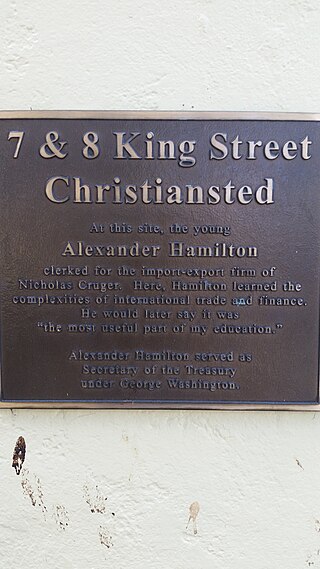
Saint Croix is an island in the Caribbean Sea, and a county and constituent district of the United States Virgin Islands (USVI), an unincorporated territory of the United States.

Saint Thomas is one of the Virgin Islands in the Caribbean Sea, and a constituent district of the United States Virgin Islands (USVI), an unincorporated territory of the United States. Along with surrounding minor islands, it is one of three county-equivalents in the USVI. Together with Saint John, it forms one of the districts of the USVI. The territorial capital and port of Charlotte Amalie is located on the island. As of the 2020 census, the population of Saint Thomas was 42,261, about 48.5% of the total population of the United States Virgin Islands. The island has a land area of 32 square miles (83 km2).

The flag of the United States Virgin Islands was adopted on May 17, 1921. It consists of a simplified version of the coat of arms of the United States between the letters V and I. The yellow-colored eagle holds a sprig of laurel in one talon, which symbolizes victory, and three blue arrows in the other, which represent the three major islands that make up the U.S. Virgin Islands: Saint Croix, Saint Thomas, and Saint John. When the Virgin Islands were owned by Denmark, the flag was a blue ensign with the Danish flag, or Dannebrog, in the canton.

Danish overseas colonies and Dano-Norwegian colonies were the colonies that Denmark–Norway possessed from 1536 until 1953. At its apex, the colonies spanned four continents: Africa, Asia, Europe, and North America.
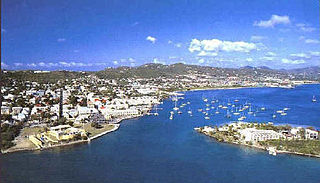
Christiansted is the largest town on Saint Croix, one of the main islands composing the United States Virgin Islands, a territory of the United States of America. The town is named after King Christian VI of Denmark.
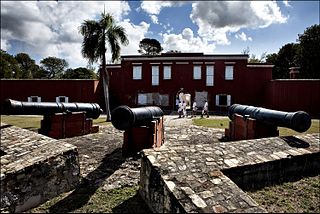
Frederiksted is both the town and one of the two administrative districts of St. Croix, U.S. Virgin Islands. It is a grid-planned city, designed by surveyor Jens Beckfor, originally to 14x14 blocks but built 7x7 to enhance the island commerce in the 1700s. Frederiksted has fewer than 1,000 people in the town proper, but nearly 10,000 in the greater western side of the island. Christiansted is about 30 years older but commerce was limited by its natural, shallow protective reef. Frederiksted was built in the leeward side of the island for calm seas and a naturally deep port. It is home to Fort Frederik, constructed to protect the town from pirate raids and attacks from rival imperialist nations and named after Frederick V of Denmark, who purchased the Danish West Indies in 1754.

The United States Virgin Islands, often abbreviated USVI, are a group of islands and cays located in the Lesser Antilles of the Eastern Caribbean, consisting of three main islands and fifty smaller islets and cays. Like many of their Caribbean neighbors, the history of the islands is characterized by native Amerindian settlement, European colonization, and the Atlantic slave trade.

Edwin Taylor Pollock was a career officer in the United States Navy, serving in the Spanish–American War and in World War I. He was later promoted to the rank of captain.
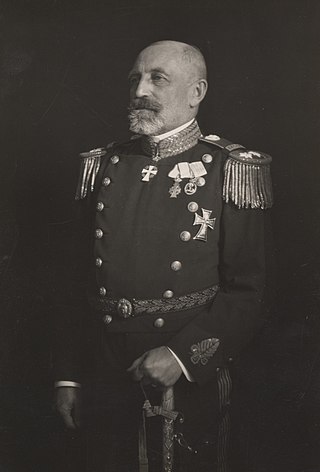
Henri Konow was a Danish naval officer, vice-admiral, and the last governor of the Danish West Indies, overseeing the transfer of administration to the United States of America following the Treaty of the Danish West Indies in 1916 under which the Kingdom of Denmark sold the islands now named the US Virgin Islands to the United States in exchange for US$25,000,000 in gold.

A referendum on the sale of the Danish West Indian Islands to the United States of America was held in Denmark on 14 December 1916. The non-binding referendum saw 283,670 vote in favor of the sale of the Danish West Indian Islands and 158,157 against. The residents of the islands were not allowed to vote on the matter, but in an unofficial vote on Saint Croix arranged by David Hamilton Jackson, 4,027 voted in favor of the sale and only seven voted against. As a result of the referendum the islands were formally relinquished to the United States by the Treaty of the Danish West Indies on 31 March 1917 as the United States Virgin Islands for a sum of US$25,000,000 in gold.

David Hamilton Jackson was a labor rights advocate in the Danish West Indies, later the United States Virgin Islands. Jackson was an important figure in the struggle for increased civil rights and workers' rights on the islands. He petitioned for freedom of the press, and organized the islands' first trade union. Following the transfer of the territory to American control in 1917, he lobbied for US citizenship for the islanders.

The following outline is provided as an overview of and topical guide to the United States Virgin Islands:

Sugar production in the United States Virgin Islands was an important part of the economy of the United States Virgin Islands for over two hundred years. Long before the islands became part of the United States in 1917, the islands, in particular the island of Saint Croix, was exploited by the Danish from the early 18th century and by 1800 over 30,000 acres were under cultivation, earning Saint Croix a reputation as the "Garden of the West Indies". Since the closing of the last sugar factory on Saint Croix in 1966, the industry has become only a memory.
Grove Place is a settlement on the island of Saint Croix in the United States Virgin Islands. It was added to the National Register of Historic Places in 1978.
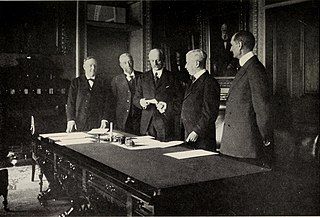
The Treaty of the Danish West Indies, officially the Convention between the United States and Denmark for cession of the Danish West Indies, was a 1916 treaty transferring sovereignty of the Virgin Islands in the Danish West Indies from Denmark to the United States in exchange for a sum of US$25,000,000 in gold. It is one of the most recent permanent expansions of United States territory.

The Danish slave trade occurred separately in two different periods: the trade in European slaves during the Viking Age, from the 8th to 10th century; and the Danish role in selling African slaves during the Atlantic slave trade, which commenced in 1733 and ended in 1807 when the abolition of slavery was announced. The location of the latter slave trade primarily occurred in the Danish West Indies where slaves were tasked with many different manual labour activities, primarily working on sugar plantations. The slave trade had many impacts that varied in their nature, with some more severe than others. After many years of slavery in the Danish West Indies, Christian VII decided to abolish slave trading.


















